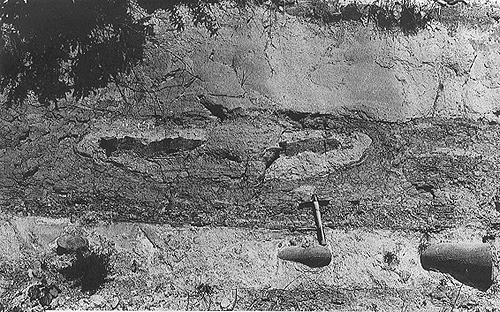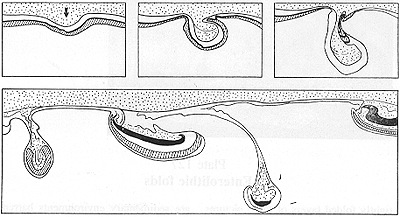

Ball-and-pillow structure (pseudonodules)
Plate 126


Ball-and-pillow structure (pseudonodules)
Plate 126
Load-formed sand lobes, sinking into a soft muddy substratum, can detach from the "mother bed" or remain linked by a narrow neck or "umbilical cord." The resulting pockets and pillow-shaped bodies were called pseudonodules by European geologists, ball-and-pillow structure by Americans.
The structure can be reproduced experimentally by putting a sand layer on thixotropic mud; and shaking the container, or by using two immiscible liquids of different density and viscosity (with the denser one obviously staying atop). The experiments demonstrate that load and inverted density gradients are not sufficient to generate the descending "drops," unless they are helped by liquefaction of both the substratum and the sand. If, in their descent, the sand drops meet an increasing resistance by stiffer mud, they can spread laterally; alternatively, they are flattened by subsequent overloading (with continuing sedimentation and deeper burial).
Buried horizons of thixotropic mud resist compaction because water expulsion is hampered; they remain in an underconsolidated state and represent horizons of weakness. Under a sloping bottom, such horizons are a cause of instability and can be involved (with overlying beds too) in slumping or debris flow; phenomena. If balls and pillows were embedded in them, they would be found as displaced structures (the term slump ball was also used).
The picture, like those shown in plates 98 and 99, has by now a historical value as the outcrop has completely deteriorated (Marnoso-arenacea Formation, northern Apennines, road Fontanelice-Casola Valsenio). Another example of ball-and-pillow, a classical one reported in the atlas by Pettijohn and Potter,3 is shown in color photo 8: the laminar flow of liquefied sand is there made visible by twirled decorations reminding classic capitals of ancient Greek temples.
Inset: modified from P. H. Kuenen 1958, Experiments in geology, Trans. Geol. Soc. (Glasgow), 23: 1-28.
Note 3: F. J. Pettijohn and P. E. Potter. 1964. Sand and Sandstone. New York: Springer Verlag. Back.